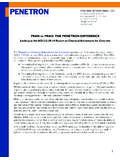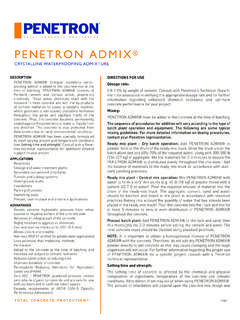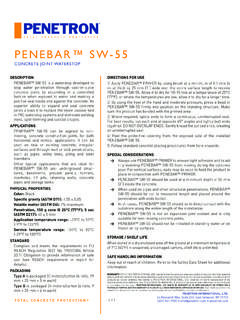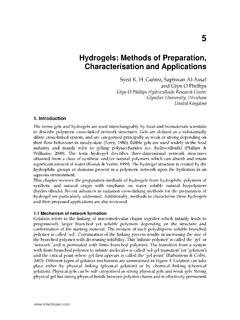Transcription of REPORT ON CHEMICAL ADMIXTURES FOR …
1 45 Research Way, Suite 203 East Setauket, NY 11733, USA+1 (631) INTERNATIONAL, LTD. TOTAL CONCRETE PROTECTION Authorized reprint permission from ACI REPORT ON CHEMICAL ADMIXTURES FOR CONCRETE ACI Reported by ACI Committee 212 CHAPTER 15 PERMEABILITY REDUCING ADMIXTURES ATTACHMENT ACI REPORT ON CHEMICAL ADMIXTURES FOR CONCRETE ACI by ACI Committee 212 REPORT on CHEMICAL Admixturesfor ConcreteCHAPTER 15 PERMEABILITY REDUCING ADMIXTURES 46 REPORT ON CHEMICAL ADMIXTURES FOR CONCRETE (ACI )American Concrete Institute Copyrighted Material bar tests (ASTM C1260 or ASTM C1567).
2 Fortesting in ASTM C1293, the limit is generally less at 2 Fig. , the LiOH and LiNO3 were both added at the100% dose; note the greater effectiveness of the LiNO3. As ademonstration of the high reactivity level of this aggregate,note that levels of Class F fly ash up to 30% were not sufficientto control the expansion of this aggregate. Often, 30% of Class Ffly ash will suppress expansion of most aggregates used forconcrete manufacture in North America. The 100% dose ofLiNO3 will not always be sufficient for every testing is recommended when using StorageLithium ADMIXTURES should be stored in strict accordancewith the manufacturer s recommendations.
3 Most admixturesare not damaged by freezing. The manufacturer s instructionsshould be followed regarding the effects of freezing theproduct. An admixture stored beyond its recommended shelflife should be retested before 15 IntroductionWhile it is generally accepted that well-proportioned andproperly cured concrete produced using a low w/cm willresult in a finished product with good durability and lowpermeability, no concrete structure is absolutely waterproofor bottle tight (Perkins 1986). Concrete is a porous mate-rial, and water can penetrate concrete through pores andmicrocracks due to capillary absorption (often referred to aswicking) or due to hydrostatic pressure.
4 Capillary absorption isthe movement of water through the small pores in concretein the absence of an externally applied hydraulic head, and isthe result of surface interactions between the water and thepore wall. The permeability of concrete is the movement ofwater due to a pressure gradient, such as water in contactwith a concrete structure installed underground. In somecases, porosity may be exacerbated by external factors suchas incomplete consolidation and curing, which may ultimatelylead to reduced durability. The addition of supplementarycementing materials (SCMs) into concrete mixtures has beengaining acceptance with respect to improving durability andreducing permeability (Munn et al.)
5 2005). In addition, a classof materials referred to as permeability-reducing ADMIXTURES (PRAs) have been developed to improve concrete durabilitythrough controlling water and moisture movement (Roy andNorthwood 1999) as well as by reducing chloride ion ingress(Munn et al. 2003) and permeability (Munn et al. 2005).PRAs encompass a range of materials with variances PRAs are traditionally subcategorized asdamproofing and waterproofing ADMIXTURES (Ramachandran1995; ACI ; Aldred 1989), perhaps it is too absoluteto state that concrete can be made waterproof.
6 Furthercomplicating matters, many concrete professionals use theterm permeability to mean the resistance of concrete towater ingress under actual service conditions. This definitionis not technically correct as it could refer to either permeabilityor capillary absorption as defined previously; however,permeability is commonly understood to refer to any passageof water through concrete. For the purpose of this chapter, ADMIXTURES intended to reduce water ingress will be split intotwo subcategories: PRAs for concrete exposed to nonhydrostaticconditions (PRAN) and PRAs for concrete exposed tohydrostatic conditions (PRAH).
7 In addition to permeabilityreduction, some PRAs may exhibit other beneficial character-istics such as reduced drying shrinkage (Munn et al. 2003),lowered chloride ion penetration (Munn et al. 2003), enhancedfreezing-and-thawing resistance (Ramachandran 1995; Rixomand Mailvaganam 1999), and enhanced autogenous sealing(Skoglund and Johansson 2003; Kubal 2000). MaterialsDepending on the manufacturer, PRAs include, but are notlimited to, materials from one or more CHEMICAL are as follows: Hydrophobic or water-repellent chemicals are thelargest group and include materials based on soaps andlong-chain fatty acid derivatives, vegetable oils(tallows, soya-based materials, and greases), andpetroleum (mineral oil, paraffin waxes, and bitumenemulsions).
8 These materials provide a water-repellentlayer along pores in the concrete, but the pores remainphysically open; Finely divided solids include materials such as inertand chemically active fillers (talc, bentonite, siliciouspowders, clay, hydrocarbon resins, and coal tar pitches)and chemically active fillers (lime, silicates, and colloidalsilica). Fine solids act as densifiers and physically restrictthe passage of water through the pores. Some authorsinclude SCMs in this category as well; and Crystalline materials consist of proprietary activechemicals provided in a carrier of cement and hydrophilic nature of these materials causes themto increase the density of calcium silicate hydrate(CHS) and/or generate pore-blocking deposits thatresist water families of materials are used alone or in combinationto give varying ranges of the most widely used PRANs for damproofingprotection under nonhydrostatic conditions are hydrophobicmaterials based on salts of fatty acids.
9 Calcium, ammonium,and butyl stearates are perhaps the most common, as well asoleic, caprylic, and capric derivatives (Ramachandran 1995;Rixom and Mailvaganam 1999). According to Ramachadran(1995), these materials react according to the following reactionCa(OH)2 + RCOOH Ca+COOR + H2 Ocalcium hydroxide + stearate admixture insoluble calcium + water. (lime)stearateThe insoluble stearate created by the reaction between theadmixture and the lime forms a hydrophobic layer on thewalls of the concrete pores.
10 Waxes and bituminous emulsions REPORT ON CHEMICAL ADMIXTURES FOR CONCRETE (ACI )47 American Concrete Institute Copyrighted Material other materials that can deposit hydrophobic particles inthe concrete pores, although there is no CHEMICAL reactioninvolved in that process. Hydrophobic ADMIXTURES are effectiveat reducing the capillary absorption and chloride ingress ofconcrete under nonhydrostatic conditions as shown in Fig. , respectively (Aldred et al. 2001; Civjan andCrellin 2008).In theory, the hydrophobically-modified concrete should beable to resist water up to ft (4 m) head pressure(Ramachandran 1995) and even up to ft (14 m) (Aldredet al.)




